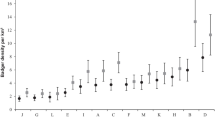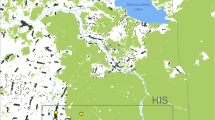Abstract—Diverse variants of the social organization of European badger populations (Meles meles L.) are observed in different parts of the living range. This paper presents information concerning the impact of the environment on the structure of European badger family groups. Data of the authors’ own observations conducted at ten model sites in the years 2011–2018 were used as the study material. The model badger settlements studied are located on the Oka–Don Plain within the administrative borders of Saratov oblast. The results of route surveys, photo trap surveys, and correlation assessment revealed a direct and strong correlation of the area occupied by a family group and the size of the group’s forage territory to the number of individuals in the group (r = 0.875 and r = 0.715, respectively). Family groups of four types (group, polygynic, monogamous, and incomplete families) were distinguished. The group type of family is formed in areas most appropriate for the badger when the amount of available food is sufficient. Large family groups inhabit such sites and construct complex systems of burrows used by many generations of badgers. Polygynic families occupy territories similar to the first type, but characterized by a small size of the forage area. Since food availability is a limiting factor, these social systems do not develop into large family groups and consist of a polygynic family of an alpha male and several females with their offspring. A small area of the family territory and a large forage area are characteristic of the social groups of the third type. A small size of the territory available is also a limiting factor, which prevents the animals from forming social groups larger than a monogamous family. The fourth type of family groups called the incomplete family is formed under an insufficient size of the territory available combined with a small size of the forage area. Quantitatively, groups of this type include a single individual and, less often, a pair of animals. These types are not permanent structures, but rather replace each other under the influence of environmental factors. The development of a family group is limited by the total size of the area suitable for vital activity and by the amount of available food resources, which is a solution to the problem of resource allocation among animals of the species studied.

Similar content being viewed by others
REFERENCES
Belyachenko, A.V., Shlyakhtin, G.V., Filipechev, A.O., Mosolova, E.Yu., Melnikov, E.Yu., Ermokhin, M.V., Tabachishin, V.G., and Emelyanov, A.V., Metody kolichestvennykh uchetov i issledoanii nazemnykh pozvonochnykh zhivotnykh (Methods of Quantitative Census and Morphological Analysis of Terrestrial Vertebrates), Saratov: Saratov. Gos. Univ., 2014.
Bokhina, O.D. and Boldyrev, V.A., Geoinformation model of the distribution of the European badger (Meles meles L., 1758) in the right-bank Saratov Volga region, Izv. Saratov. Gos. Univ., Nov Ser.: Chem. Biol. Ecol., 2017, vol. 17, no. 3, pp. 363–364.
Bondarev, A.I., Dezhkin, A.V., and Pavlov, P.M., On methods for taking census of badgers, in Sostoyanie sredy obitaniya i fauna okhotnich’ikh zhivotnykh Rossi ii sopredel’nykh teritorii (The Fauna of Game Animals and Their Habitat Conditions in Russia and Adjacent Territories: Proc II International and VII All-Russia Sci.-Pract. Conf.), Balashikha: Ross. Gos. Zaochn. Agr. Univ., 2016, pp. 42–47.
Doncaster, C.P. and Woodroffe, R., Den site can determine shape and size of badger territories: implications for group living, Oikos, 1993, vol. 66, no. 1, pp. 88–93.
Gaughran, A., Kelly, D.J., MacWhite, T., Mullen, E., Maher, P., Good, M., and Marples, N.M., Super-ranging. A new ranging strategy in European badgers, PLoS One, 2018, vol. 13, no. 2, e0191818. https://doi.org/10.1371/journal.pone.0191818
Grishin, P.N., Kravchenko, V.V., and Boldyrev, V.A., Pochvy Saratovskoi oblasti, iks proiskhozhdenie, sostav i agrokhimcheskie svoistva (Soils of Saratov Oblast: Origin, Composition, and Agrochemical Properties), Saratov: Saratov. Gos. Univ., 2011.
Johnson, D.P., Macdonald, D.W., Newman, C., and Morecroft, M.D., Group size versus territory size in group-living badgers: a large-sample field test of the Resource Dispersion Hypothesis, Oikos, 2001, vol. 95, no. 2, pp. 265–274.
Johnson, D.P., Kays, R., Blackwell, P., and Macdonald, D.W., Does the resource dispersion hypothesis explain group living?, Trends Ecol. Evol., 2002a, vol. 17, no. 12, pp. 563–570.
Johnson, D.P., Jetz, W., and Macdonald, D.W., Environmental correlates of badger social spacing across Europe, J. Biogeogr., 2002b, vol. 29, no. 3, pp. 411–425.
Kruuk, H. Spatial organization and territorial behaviour of the European badger Meles meles, J. Zool., 1978, vol. 184, no. 1, pp. 1–19.
Macdonald, D.W., The ecology of carnivore social behavior, Nature, 1983, vol. 301, pp. 379–384.
Novikov, G.A., Polevye issledovaniya po ekologii nazemnykh pozvinichnykh (Field Studies on the Ecology of Terrestrial Vertebrates), Moscow: Akad. Nauk SSSR, 1953.
Pryakhina, S.I. The climate of Saratov oblast, in Entsiklopediya Saratovskogo kraya (v ocherkakh, sobytiyakh, faktakh, imenakh) (Encyclopedia of the Saratov Region in Essays, Events, Facts, and Names), 2nd ed., Saratov, Privolzhskoye Knizhn. Izd., 2011, pp. 23–25.
Shilina, M.V., Musatova, O.V., and Ivanovskii, V.V., Biometriya (Biometrics), Vitebsk: Vitebsk. Gos. Univ. im. P.M. Masherova, 2011.
Sidorchuk, N.V., Volchenko, A.Ye., and Rozhnov, V.V., Daily activity of the European badger (Meles meles Linnaeus, 1758) (Mustelidae, Mammalia) in settlements in different populations of the European part of Russia, Povolzh. Ekol. Zh., 2014, no. 4, pp. 601–610.
Stopka, P. and Johnson, D.P., Badger (Meles meles) as a model species for the development of ecological and behavioural research, Lynx, 2000, vol. 31, no. 2, pp. 125–131.
Von Schantz, T., Carnivore social behavior: Does it need patches?, Nature, 1984, vol. 307, pp. 389–390.
Woodroffe, R. and Macdonald, D.W., Helpers provide no detectable benefits in the European badger (Meles meles), J. Zool., 2000, vol. 250, no. 1, pp. 113–119.
Zolotukhin, A.I. and Ovcharenko, A.A., Poimennye lesa Prikhoper’ya: sostoyanie, ekologicheskaya struktura, bioraznoobrazie (Floodplain Forests of the Khoper Region: State, Ecological Structure, and Biodiversity), Balashov: Nikolaev, 2007.
Zolotukhin, A.I., Shapovalova, A.A., Ovcharenko, A.A., and Zanina, M.A., Antropogennaya dinamika struktury i bioraznoobraziya poimennykh dubrav Srednego Prikhoper’ya (Anthropogenic Dynamics of Structure and Biodiversity in Floodplain Oak Forests of the Middle Khoper Region), Balashov: Nikolaev, 2010.
Author information
Authors and Affiliations
Corresponding author
Ethics declarations
The authors declare that they have no conflict of interest. This article does not contain any studies involving animals or human participants performed by any of the authors.
Additional information
Translated by S. Semenova
Rights and permissions
About this article
Cite this article
Bohina, O.D., Boldyrev, V.A. Influence of the Environment on the Structure of the European Badger (Meles meles) (Mustelidae, Mammalia) Family Groups on the Oka–Don Plain. Biol Bull Russ Acad Sci 46, 1364–1367 (2019). https://doi.org/10.1134/S1062359019100066
Received:
Revised:
Accepted:
Published:
Issue Date:
DOI: https://doi.org/10.1134/S1062359019100066




